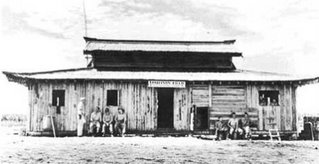 The Pagoda at Henderson Field, served as headquarters for Cactus Air Force throughout the first months of air operations on Guadalcanal. From this building, Allied planes were sent against Japanese troops on other islands of the Solomons.
The Pagoda at Henderson Field, served as headquarters for Cactus Air Force throughout the first months of air operations on Guadalcanal. From this building, Allied planes were sent against Japanese troops on other islands of the Solomons. On 18 September, the long-awaited 7th Marines, reinforced by the 1st Battalion, 11th Marines, and other division troops, arrived at Guadalcanal. As the men from Samoa landed they were greeted with friendly derision by Marines already on the island. The 7th had been the first regiment of the 1st Division to go overseas; its men, many thought then, were likely to be the first to see combat. The division had been careful to send some of its best men to Samoa and now had them back. One of the new and salty combat veterans of the 5th Marines remarked to a friend in the 7th that he had waited a long time "to see our first team get into the game." Providentially, a separate supply convoy reached the island at the same time as the 7th's arrival, bringing with it badly needed aviation gas and the first resupply of ammunition since D-Day.
The Navy covering force for the reinforcement and supply convoys was hit hard by Japanese submarines. The carrier Wasp was torpedoed and sunk, the battleship North Carolina (BB-55) was damaged, and the destroyer O'Brien (DD-415) was hit so badly it broke up and sank on its way to drydock. The Navy had accomplished its mission, the 7th Marines had landed, but at a terrible cost. About the only good result of the devastating Japanese torpedo attacks was that the Wasp's surviving aircraft joined Cactus Air Force, as the planes of the Saratoga and Enterprise had done when their carriers required combat repairs. Now, the Hornet (CV-8) was the only whole fleet carrier left in the South Pacific.As the ships that brought the 7th Marines withdrew, they took with them the survivors of the 1st Parachute Battalion and sick bays full of badly wounded men. General Vandegrift now had 10 infantry battalions, one understrength raider battalion, and five artillery battalions ashore; the 3d Battalion, 2d Marines, had come over from Tulagi also. He reorganized the defensive perimeter into 10 sectors for better control, giving the engineer, pioneer, and amphibian tractor battalions sectors along the beach. Infantry battalions manned the other sectors, including the inland perimeter in the jungle. Each infantry regiment had two battalions on line and one in reserve. Vandegrift also had the use of a select group of infantrymen who were training to be scouts and snipers under the leadership of Colonel William J. "Wild Bill" Whaling, and experienced jungle hand, marksman, and hunter, whom he had appointed to run a school to sharpen the division's fighting skills. As men finished their training under Whaling and went back to their outfits, others took their place and the Whaling group was available to scout and spearhead operations.
Vandegrift now had enough men ashore on Guadalcanal, 19,200, to expand his defensive scheme. He decided to seize a forward position along the east bank of the Matanikau River, in effect strongly outposting his west flank defenses against the probability of string enemy attacks from the area where most Japanese troops were landing. First, however, he was going to test the Japanese reaction with a strong probing force.
He chose the fresh 1st Battalion, 7th Marines, commanded by Lieutenant Colonel Lewis B. "Chesty" Puller, to move inland along the slopes of Mt. Austen and patrol north towards the coast and the Japanese-held area. Puller's battalion ran into Japanese troops bivouacked on the slopes of Austen on the 24th and in a sharp firefight had seven men killed and 25 wounded. Vandegrift sent the 2d Battalion, 5th Marines, forward to reinforce Puller and help provide the men needed to carry the casualties out of the jungle. Now reinforced, Puller continued his advance, moving down the east bank of the Matanikau. He reached the coast on the 26th as planned, where he drew intensive fire from enemy positions on the ridges west of the river. An attempt by the 2d Battalion, 5th Marines, to cross was beaten back.
About the time, the 1st Raider Battalion, its original mission one of establishing a patrol base west of the Matanikau, reached the vicinity of the firefight, and joined in. Vandegrift sent Colonel Edson, now the commander of the 5th Marines, forward to take charge of the expanded force. He was directed to attack on the 27th and decided to send the raiders inland to outflank the Japanese defenders. The battalion, commanded by Edson's former executive officer, Lieutenant Colonel Samuel B. Griffith II, ran into a hornet's nest of Japanese who had crossed the Matanikau during the night. A garbled message led Edson to believe that Griffith's men were advancing according to plan, so he decided to land the companies of the 1st Battalion, 7th Marines, behind the enemy's Matanikau position and strike the Japanese from the rear while Rosecran's men attacked across the river.
No comments:
Post a Comment